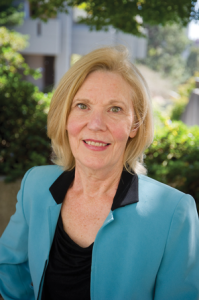
In our new Gilded Age, one antidote to crony capitalism may be “Buddhist economics,” the subject of UC Berkeley professor emeritus Clair Brown’s new book, Buddhist Economics: An Enlightened Approach to the Dismal Science. We asked Brown to pose a few questions about her book’s title, a term first coined in 1973, and the future of sustainable growth and prosperity.
1. The study of economics examines what makes people happy, and that answer depends on our assumptions about human nature. Buddhist economics assumes human nature is generous and altruistic. True happiness comes from helping others, and suffering comes from our own mental states that cause us to desire more and more. We can end suffering by changing our state of mind, by replacing the endless cycle of desire with more positive, collective priorities. As we become happier by caring for others, relationships become more important than possessions.
Free-market economics rests on the very different assumption that human nature is self-centered. People care only about themselves as they maximize their incomes and fancy life styles. Buying and consuming make people happy, at least temporarily. More is always better, and so people keep buying without finding lasting satisfaction. How can we communicate to Americans that it’s time to stop filling our closets and join together to create meaningful lives?
2. Countries around the world measure economic performance by the growth of average national output (GDP) or average income per person. Then analysts use GDP per person to compare well-being across countries. Yet economists agree that GDP does not measure well-being because, by excluding everything except market transactions, it ignores many valuable activities of daily life. Housework and childcare are ignored, leisure activities are valued by the goods and services purchased, and health and longevity are registered only by how much we spend on health care. How income is distributed across families is ignored. Growth in GDP that increases incomes of the wealthy is undifferentiated from growth in GDP that increases incomes of the needy. But economists do have metrics for measuring economic performance as quality of life, such as the Genuine Progress Indicator or the Better Life Index. Why don’t economists put less emphasis on GDP and instead measure economic performance in a way that evaluates how well our economies are providing a higher quality of life for everyone?
3. The United Nations Millennium Development Goals, a 15-year program to improve the lives of the world’s poorest people by 2015, demonstrated that coordinated global efforts can pay off. The number of people living in extreme poverty fell from almost two billion to just under 900 million, or from 47 percent of the developing world population in 1990 to 14 percent in 2015. The child mortality rate declined by half. The number of people lacking safe drinking water dropped from 1.2 billion in 1990 to 663 million in 2012. Enrollment in primary education increased to 91 percent. Women’s lives improved across the world: more women held jobs outside agriculture, and more women were elected to national positions.
The U.N.’s Sustainable Development Goals for 2030, adopted two years ago, incorporate benchmarks for both rich and poor nations because shared prosperity requires rich nations to reduce their carbon footprint and to provide technology and resources to poor countries to improve their quality of life. Will these new goals ensure that wealthy nations take concerted action and provide resources to developing countries so that everyone can share in sustainable prosperity?
4. The effect of our integrated global economy on national economies is another way that free-market economics and Buddhist economics diverge. Free-market economics teaches that international trade can result only in higher incomes for all countries, with no country losing. Each country specializes in what it does well (“comparative advantage”), and then nations trade and share in the gains from trade. In today’s highly mechanized modern global economy, many countries use the same production processes, and the price of labor drives trade patterns—and outsourcing. Now gains from trade reflect the countries’ global bargaining power, and the rich country dominates the poor country. Buddhist economics suggests that trade agreements between countries be based on fair labor laws, equitable wages, and environmental protection. How can companies begin to shift from unfair labor practices and environmental degradation so that all countries can benefit from the global economy?
5. Two major economic problems—global warming and inequality—can be solved with policies that restructure the economy to reduce inequality and carbon emissions. Beginning in the 1980s, as the United States deregulated the financial markets and lowered income taxes for the rich, income inequality soared, but the government did little to alleviate it. Scientists warned us decades ago that our fossil fuel economy was causing global warming, and yet we did not take concerted action until the Paris Agreement of 2015. If the new U.S. administration fails to enact policies to curb global warming and vast inequality, will other countries adopt them and create a roadmap for an equitable, sustainable economy?


